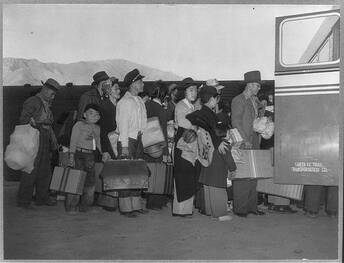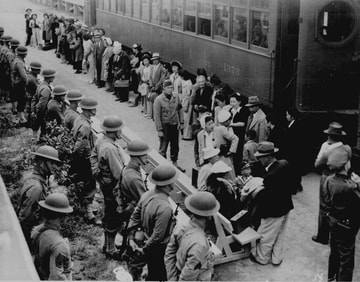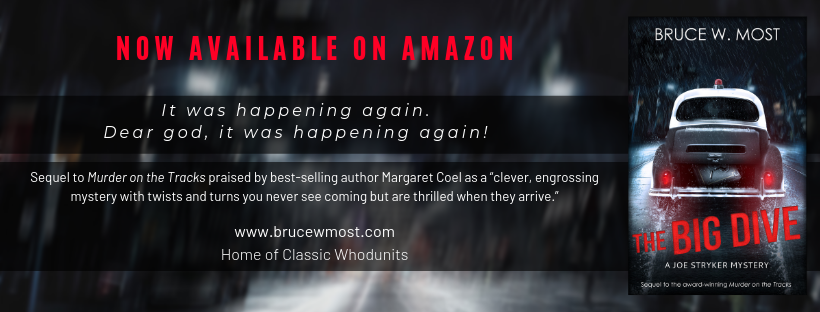|
A dark stain in American history has resurfaced in the news, over 75 years after its occurrence. That dark stain also inspired a major plot line that runs through my historical mystery The Big Dive.  On February 19, 1942, President Franklin Roosevelt signed Executive Order 9066. [click here]. The order authorized the forcible removal from the West Coast of 120,000 residents of Japanese ancestry from their homes and businesses, and their subsequent incarceration in ten hastily constructed “relocation camps.” This came two-and-a-half months after the bombing of Pearl Harbor, and our swift declaration of war against Japan, Germany, and Italy. Roughly, two-thirds of the “evacuees” were American citizens. The rest were Japanese who had lived in the states for years. (America had prevented immigration of Japanese since 1924.) The majority of these evacuees lived in California. The rest resided in Oregon, Washington, and Hawaii. If you were a Japanese American living in Chicago, Miami, or Poughkeepsie, New York, you could go about your daily life as usual (except for harassment by Americans suspicious of anyone who appeared “Oriental”). The official rationale for incarcerating these ethnic Japanese was for protecting America “against espionage and against sabotage.” It was not FDR’s finest moment. His executive order also applied to a significantly smaller number of residents of Italian and German descent. The Justice Department arrested and imprisoned a few hundred of them. But no mass relocation camps for the Caputos and Schmidts. They were exclusive to Japanese. “A Mistake of Terrifically Horrible Proportions” Title of essay by novelist and journalist John Hersey for a photography book on one of the camps “Civilian exclusion orders” went up in March 1942 along the West Coast. Japanese Americans typically were given from a few days to two weeks to put their affairs in order before being carted off to camps. They could take only what they could carry by hand. That meant selling off their homes, prosperous businesses and farms, and personal property. Some entrusted their property to white neighbors and friends. That almost always proved a disastrous mistake. When one strawberry farmer asked for a delay of a few days to harvest his crop, military officials refused. He plowed under his crop. They arrested him for sabotage and put him in jail. Camp Amache The 120,000 (including entire families) were transported on trains, armed-escorted auto caravans, and military buses to inland camps in California, Utah, Arizona, Wyoming, and, of all places, Arkansas. . . . . . . And to a camp in the desolate corner of southeast Colorado, formally known as the Granada War Relocation Center named after the nearby community of Granada. Camp Amache for short. A camp that figures into my novel. Smaller numbers of Japanese men—“alien enemies”—were arrested and imprisoned at mostly military bases, such as Fort Sill, Oklahoma (also referenced by activists. How and why this mass removal and incarceration of largely American citizens came about is too long and complicated for this series of blogs. But bluntly put, it was a case of mass war hysteria by public and military officials, the press, and non-Japanese citizens, with little opposition. “There is not a single Japanese in this country who would not stab you in the back. Show me a Jap and I'll show you a person who is inherently deceptive.” Sen. Tom Stewart, D., Tenn [click here] Today, most Americans view the incarceration of these Japanese Americans as an ugly display of racism and whipped-up war hysteria. Though sadly, some still contend it was the proper decision.  Hence, in light of the much-debated detention facilities for asylum seekers and illegal immigrants on our southern border, the history of Japanese-American relocation camps has been resurrected. Activists such as actor George Takei of Star Trek fame (who lived as a child for four years in a camp) are drawing parallels between today’s detention facilities and the relocation camps. “Concentration camps,” they often call them, a phrase I’ll discuss in my next blog. And to my surprise, I discovered that the second season of AMC’s supernatural horror anthology, The Terror, focuses on a shapeshifter haunting a Japanese-American internment camp. How appropriate. Naturally, I’m not going to divulge my plot line that draws on this dark time in our history. Let’s just say some of what you read in the coming blogs provided rich fodder for key elements and characters in my book. Topics I plan to explore in coming weeks include:
How familiar are you with the history of the Japanese-American internment camps? I’d love to hear your comments and questions.
5 Comments
Leslee Sandberg
7/23/2019 03:26:29 pm
I’ve known about the Japanese internment camps. There was a German camp here in Iowa during the war as well. I’m looking forward to learning
Reply
Bruce
7/31/2019 07:20:07 pm
I hope so, too. I found the corrupt cops and the relocation camps fascinating material for my book.
Reply
Christopher Preston
8/1/2019 09:45:46 pm
The poet Kabir articulated, "What was true then, is true now."
Reply
Bruce
8/2/2019 03:48:46 pm
True, though in FDR's case the constituent fear was widespread across both parties. Few constituents, let alone those in power, objected.
Reply
Leave a Reply. |
Bruce Most is an award-winning mystery novelist and short-story writer. His latest novel, The Big Dive, is the sequel to the award-winning Murder on the Tracks, which features a street cop seeking redemption while investigating a string of murders in 1949 Denver. His award-winning Rope Burn involves cattle rustling and murder in contemporary Wyoming ranch country. Bonded for Murder and Missing Bonds features feisty Denver bail bondswoman, Ruby Dark. Archives
February 2022
Categories |

 RSS Feed
RSS Feed